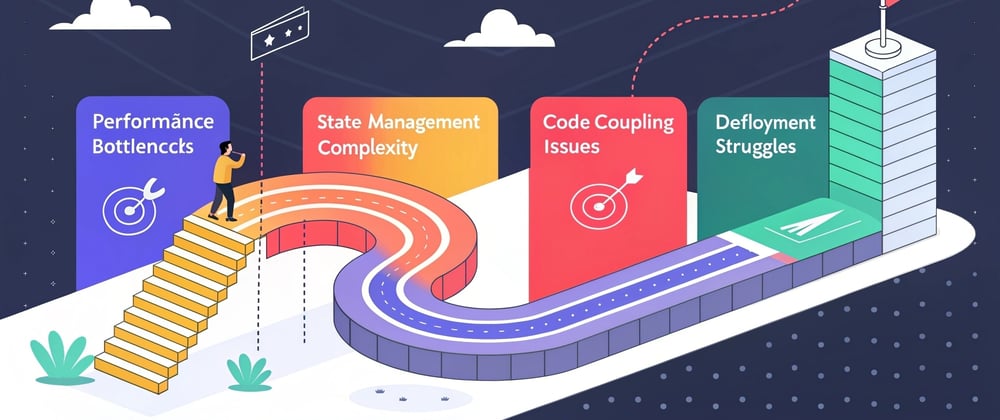Introduction: The Growing Pains of a Frontend Codebase
Every frontend project starts small and simple—a few components, some state management, maybe a couple of API calls. Fast forward a year, and suddenly:
❌ Code reviews take forever
❌ Making a small UI change breaks unexpected parts of the app
❌ Deployments become stressful, debugging is a nightmare
❌ Onboarding new developers takes weeks
I’ve been through multiple frontend projects that hit these exact roadblocks. Looking back, there are things I wish I had done earlier to avoid the mess.
In this article, I’ll share 10 key lessons I’ve learned about scaling frontend codebases the hard way.
1️⃣ Keep the Codebase Modular From Day One
- The mistake: Everything was dumped into a single components/ folder with zero structure.
-
The fix: Organize by feature, not type (e.g.,
features/dashboard/instead ofcomponents/). - Takeaway: A modular codebase scales better, and refactoring later is painful.
✅ Best Practice:
📌 Use feature-based architecture
📌 Keep components small & reusable
📌 Separate UI, state, and logic early
2️⃣ Choose the Right State Management Approach Early
- The mistake: We started with a custom state manager, which worked until it didn’t.
- The fix: Use the simplest state management solution that fits your needs (Context API, Zustand, Redux, or React Query).
- Takeaway: Overcomplicated state management is a tech debt time bomb.
✅ Best Practice:
📌 Keep local state inside components whenever possible
📌 Use React Query for server state instead of Redux
📌 Avoid prop drilling hell with Context or Zustand
3️⃣ CI/CD & Automated Deployments Are Not an Afterthought
- The mistake: Manual deployments led to human errors and broken releases.
- The fix: Automate the entire process (testing, builds, deployments) using CI/CD tools.
- Takeaway: If you don’t automate early, you’ll regret it when your team grows.
✅ Best Practice:
📌 Set up NX or Turborepo for efficient builds
📌 Use feature flags to safely deploy unfinished features
📌 Run automated tests before merging
4️⃣ Performance Optimization Is Important
- The mistake: We didn’t care about performance until users started complaining.
- The fix: Optimize early by monitoring bundle sizes and network requests, note any unnecessary re-renders.
- Takeaway: Performance bottlenecks are much harder to fix later.
✅ Best Practice:
📌 Use lazy loading & code splitting (React’s Suspense)
📌 Optimize bundle size with tree shaking
📌 Minimize re-renders with React.memo & useCallback
5️⃣ Proper Testing Saves You From Deployment Nightmares
- The mistake: We relied on manual testing instead of automating tests.
- The fix: A solid test strategy includes unit, integration, and E2E tests.
- Takeaway: The best time to start writing tests was yesterday.
✅ Best Practice:
📌 Write unit tests for critical business logic
📌 Use React Testing Library for component tests
📌 Add Cypress or Playwright for E2E tests
6️⃣ Avoid Over-Engineering: Simple Is Better
- The mistake: We overcomplicated everything with abstractions and unnecessary layers.
- The fix: Build for today’s needs, but design with tomorrow in mind.
- Takeaway: Complexity grows fast; keep it as simple as possible.
✅ Best Practice:
📌 Don't abstract too early—wait until patterns emerge
📌 Avoid unnecessary custom hooks if built-in hooks work fine
📌 Keep dependencies minimal to reduce tech debt
7️⃣ Documentation Is a Lifesaver
- The mistake: The codebase relied on tribal knowledge, making onboarding painful.
- The fix: Keep lightweight, useful documentation (not just API specs).
- Takeaway: Well-documented projects are easier to scale.
✅ Best Practice:
📌 Use Storybook for UI documentation
📌 Maintain a simple README with architecture decisions
📌 Write code comments where necessary (but don’t overdo it)
8️⃣ TypeScript Will Save You From a Lot of Debugging
- The mistake: Started with plain JS, then struggled with undefined errors everywhere.
- The fix: Adopted TypeScript to reduce runtime errors.
- Takeaway: Types catch issues before they become bugs.
✅ Best Practice:
📌 Use TypeScript from day one
📌 Type function props and API responses properly
📌 Keep types clean (avoid any at all costs!)
9️⃣ API Communication Should Be Standardized
- The mistake: Different parts of the app handled API requests inconsistently.
- The fix: Created a unified API service with consistent response types and error handling.
- Takeaway: Standardized API calls reduce bugs & improve maintainability.
✅ Best Practice:
📌 Use React Query or SWR for fetching
📌 Centralize API logic in a single module
📌 Use error boundaries to catch failures gracefully
🔟 Scaling a Frontend Isn’t Just About Code; It’s About Process
At the end of the day, a scalable frontend isn’t just good architecture—it’s also about workflow, automation, and team collaboration.
If I could go back in time, I’d tell myself:
✅ Plan for modularization early
✅ Keep things simple
✅ Invest in automation, testing, and CI/CD before they become pain points
💡 What’s your biggest lesson from scaling a frontend? Let’s discuss in the comments!



Top comments (0)